Dumbbell Bench Press: Best for Pectorals Posted in: Workout – Tags: bench, dumbbell, pectorals, workout
Dumbbell Bench Press
The activation of the pectoral muscles in the bench press is significantly increased when the athlete changes the barbell for dumbbells. This is due to the fact that the straight bar of the bar closes the athlete’s straight arms into a rigid “frame”. As a result, the front beams of deltas are forced into the exercise and take on part of the load. More precisely, it is taken from the pectoral muscles. And who needs this? The dumbbell bench press is devoid of such a disadvantage.
Dumbbell bench press: how to do the exercise correctly
There are dumbbells and a straight bench in almost any gym. The dumbbell press on a straight bench is a basic exercise for building the muscles of the chest, and, in part, the triceps and the anterior deltoid muscle. Unlike the barbell press, it is more demanding on the balance of the athlete, and allows you to develop muscles more symmetrically. Therefore, the movement is used as an auxiliary in power sports, and as one of the main ones in bodybuilding.
Exercise technique
Inventory: press bench, dumbbells.
Main muscles: pectoralis major and minor.
Additional muscles: anterior delts, triceps.
Stabilizing Muscles
- Shoulders: Serratus anterior, pectoralis major, rhomboid, lower trapezius.
- Shoulder joint: Rotator cuff muscles, biceps brachii.
- Moderate trunk stabilization: Abdominal and gluteal muscle groups, latissimus dorsi.
Training level: from beginners to advanced.
Step 1. Starting position: lying on a bench, dumbbells are at the chest in bent arms, elbows are laid to the sides.
Step 2. After taking a deep breath, squeeze the dumbbells up onto fully extended arms. Exhale at the top.
Step 3. Taking the next breath, smoothly return to the starting position.
If, in the upper position, the dumbbells are brought closer to each other, turning the palms inward, then not only the amplitude of movement will increase, but also the peak tension in the middle part of the pectoral muscles.
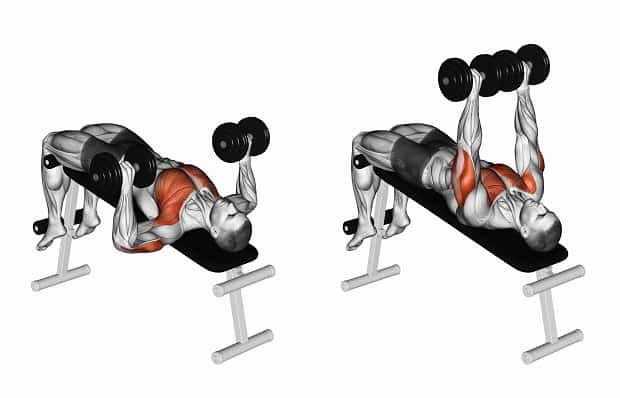
Tips for correct exercise technique:
- Learn the correct technique for performing movements before increasing the weight of the weights.
- Avoid using the force of inertia; use slow, controlled movement.
- When moving up, do not allow lifting weights nearby, keep them at a distance of about 15 cm from each other. Exhale as you lift the dumbbells.
| Movement analysis | Joint 1 | Joint 2 | Joint 3 |
| Joints | Elbow | Brachial | Scapular-thoracic articulation |
| Directions of movement in the joints | Up – extension Down – flexion | Up – adduction in the horizontal plane, flexion Down – abduction in the horizontal plane, extension | Up – incomplete upward abduction, abduction Down – incomplete mixing together and down, adduction |
| Mobilizing muscles | Triceps brachii | Pectoralis major muscle, emphasis on the sternocostal and clavicular parts Coracohumeral muscle Front of the deltoid muscle | Serratus anterior muscle |
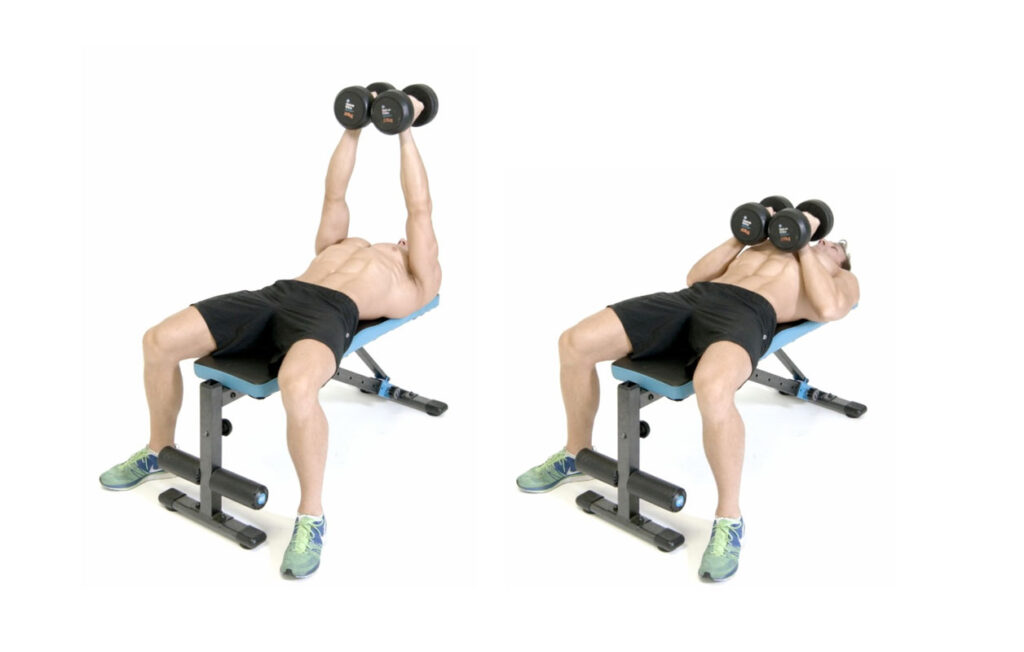
Dumbbell press lying on fitball
Inventory: fitball, dumbbells.
Main muscles: chest.
Additional muscles: triceps and front part of the deltoid muscle.
Training level: beginner, intermediate.
Correct dumbbell press
Try not to connect or hit the dumbbells. In the lower phase, during the start, do not push your elbows off the ball, making it easier to move.
- Step 1. Starting position: lying on the fitball. Place your feet slightly wider than your shoulders. Hold the dumbbells in bent arms at chest level with an overhead grip.
- Step 2. Exhale and lift the dumbbells up.
- Step 3. Return to starting position.
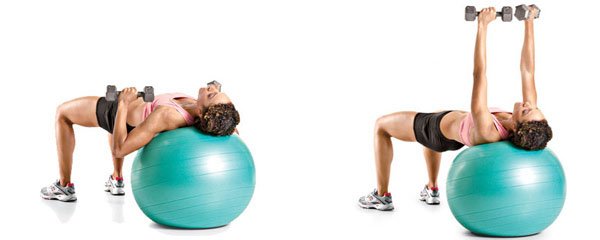
Dumbbell bench press
This exercise is suitable both at the initial stage of training for a more comfortable performance, and when recovering from injuries.
Benefits
The dumbbell press has many amazing benefits. Firstly, nowadays few people do dumbbell presses, and barbell presses, on the contrary, are very popular. Such “unpopularity” of dumbbell presses can go into your hands. Subject to the availability of dumbbells that suit you, in a modern, crowded gym, where you often have to stand in a long line to do the bench press with a barbell, you can do dumbbell presses. Second, no power rack or other safety devices are required to perform the dumbbell bench press. In addition, the presence of a helper is optional (although highly recommended). Thirdly, often people who, for some reason related to their physique, cannot perform barbell presses, can nevertheless do dumbbell presses.
Disadvantages
But the dumbbell press has several disadvantages as well. Firstly, it is quite difficult to lie down on the bench and get up from it with two heavy dumbbells in your hands, unless you have at least one intelligent assistant. Otherwise, it will not be injured for long. Secondly, exercising with dumbbells you are at greater risk of stretching your muscles than exercising with a barbell. Thirdly, if during a set you lose control of one dumbbell or two at once, then serious injury may occur – not to mention damage to the floor and equipment. But of course, the barbell press can also be very dangerous if you don’t do it inside the power rack with the restraints correctly set. A lot of ribs and shoulders suffered as a result of losing control of the bar. Some people even lost their lives doing bench presses.
Recommendations
Be careful when starting a dumbbell bench press, learn to stay in control of them before embarking on intense progressive weights – and the dumbbell press will do you well. However, keep in mind that the dumbbell bench press is not the only alternative to the barbell bench press. If the bench press stands in your gym are constantly busy and you can’t reschedule your workout, you can switch to parallel bar push-ups. It is assumed that you have decent push-up bars in your gym and that you are strong enough to perform them. When done with good technique, push-ups can be safer and more practical than the dumbbell bench press – at least for most people. Or you can do a bench press with a slight incline.
Training features
The peculiarities of building a training plan with a dumbbell press depend on the level of the athlete and his general goals.
Beginners
This is usually the second exercise given to beginners after push-ups. An exception is a person who has a symmetrical body and sufficient strength to start working immediately with a barbell half of his weight. In the case of a beginner, the dumbbell press will be the main basic movement. It will be performed at the beginning of the workout and “run” 2 times a week. This is necessary to get the movement skill. It is impossible to overload the joints and the nervous system at this stage due to the fact that small weights are used. The work style is no more than 30 seconds under load, usually equivalent to 8-10 reps per set, with a minute of rest and 3-4 working sets.
Experienced
Without learning to bench press on a straight bench. If a person’s goal is purely aesthetic, and heavy bench press does not interest him, after the initial set of strength, he is taught to press on the bench at an angle to ensure maximum chest hypertrophy. And the dumbbell press is given during the “second” or “light” workout, in order to work out a muscle group at different angles and more harmonious development. At the same time, the mesocycle takes not one week, as with professionals, but two. That is, two conditional “Mondays” are chest days, and in the first, the athlete presses the barbell at an angle, and in the second, he starts with a dumbbell press on a straight line.
Professional
Various options are allowed here – using the dumbbell press on the main workout of the chest as a second exercise, using it on an “easy” day, adding it to supersets with “stretching” exercises like raising dumbbells or push-ups with extremely wide arms.
Dumbbell Bench Press Technique
To take the starting position before the dumbbell press, you must lie down on the bench, and your assistant must give you both dumbbells in turn. Alternatively, you can take the starting position yourself, without assistance. Sit on the edge of a bench, holding the dumbbells upright on your hips near your torso. You need to make sure to keep the dumbbells centered. Keeping your arms bent at the elbows, bring your chin to your chest. Pushing the dumbbells with your feet towards you, roll over backward, keeping your back round. Keeping your forearms upright, start pressing immediately. During the press, your legs should be stable, place a block under them, as with the bench press.
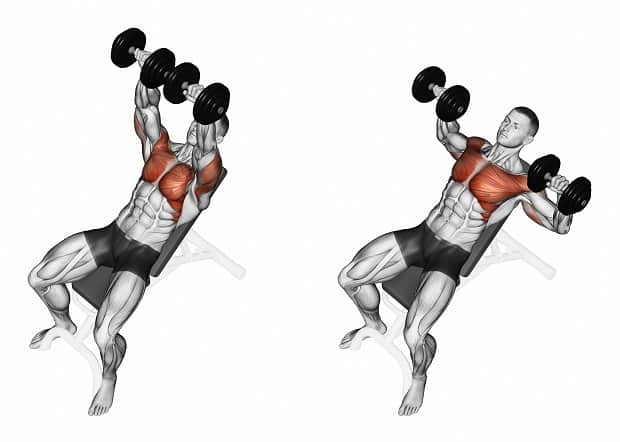
Press the dumbbells in the same trajectory as you squeeze the barbell: the bottom position is the same as with the barbell press, but perhaps if there is less horizontal component in the trajectory, this will allow you to maintain better control over the dumbbells. The dumbbells should move in the same way. They should not “drift” to the sides, one hand should not be ahead of the other.
When pressing dumbbells, you can hold them differently, not like a barbell. You can keep them parallel to each other or whatever else is more convenient for you. You can even change the position of your wrists as you move. That’s why dumbbells are convenient because they allow you to hold your wrists in almost any position, unlike a barbell.
Do not aim for excessive amplitude in the dumbbell press. The distance between your arms should be about the same as when you press the barbell. Do not do dumbbell presses with an overly wide grip, trying to lower your arms as low as possible at the lowest point of the amplitude. Lower your arms down no lower than you do with the bench press.
For the first few workouts, use light dumbbells and don’t go to failure. Wait until you learn to maintain full control over the dumbbells. Only after that you can give all the best in the exercise. Perhaps now you have poor control of the dumbbells. But as you get more and more accustomed to the exercise, your dumbbell control cannot help but improve.
The assistant should kneel behind your head and keep his hands under your elbows. This way he will be really ready to help you. But don’t do this exercise to failure. When there is one repetition to failure, stop, otherwise you risk losing control of the dumbbells. Losing control can cost you serious injury. Even the most attentive assistant will not be able to do anything if you, having reached failure, suddenly lose control of both dumbbells at the same time.
The assistant (it is better if there are two of them) should remove the dumbbells from you at the end of the set. Alternatively, you can get up off the bench by yourself, holding the dumbbells in your hands. It is done like this: lower the dumbbells to the lower part of the torso, without relaxing the muscles of the arms, shoulder girdle and chest, raise the bent knees as high as possible. When your hips touch the dumbbells, press your chin to your chest and immediately “throw” your legs forward and roll into a sitting position. It is easier to do this if your assistant rests his hands on your shoulders and helps you roll and sit up straight.
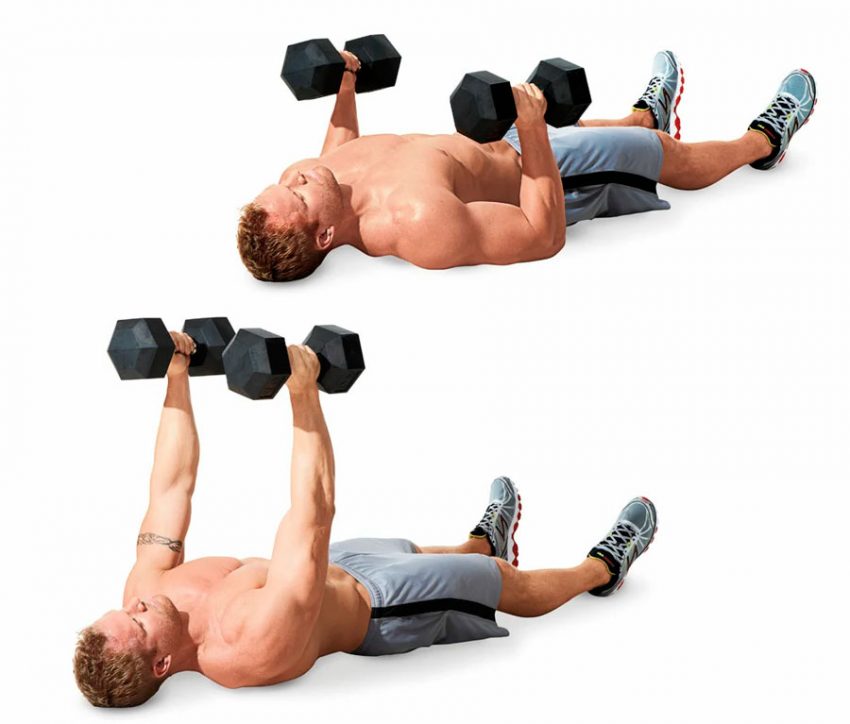
Typically, fixed weight dumbbells have a 2.5kg pitch. We multiply it by two dumbbells and get a total of 5 kg, which is a very large increase. Continue to press with dumbbells of a certain weight until you can easily do several repetitions more than your target number, and only then move on to higher dumbbells. You should also not tie extra weight to the wrists, trying to make the transition from one dumbbell to another, heavier one, smoother. It is a bad idea. Weights strapped to your wrists can throw you off balance.
If you have collapsible dumbbells, then you can add not 2.5 kg, but less if you have small pancakes. Even if you only have fixed weight dumbbells, you can attach small plates to each dumbbell. Use strong duct tape for this purpose and make sure the plates are securely attached to the dumbbells. Over time, you will reach a weight equal to the fixed weight of the next dumbbells. To make it easier for you to balance and maintain control of the dumbbells, attach small pancakes equally to both ends of each dumbbell. There is also an alternative: you can use small pancakes-magnets.



